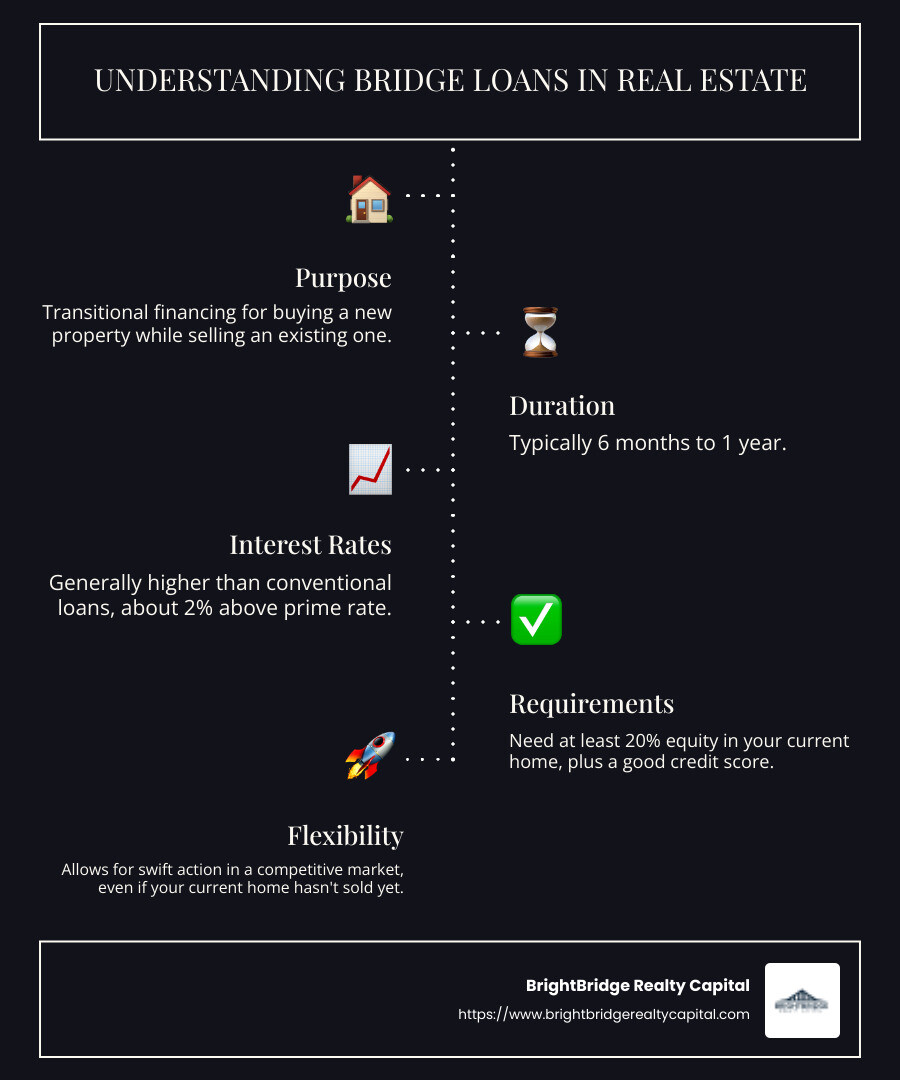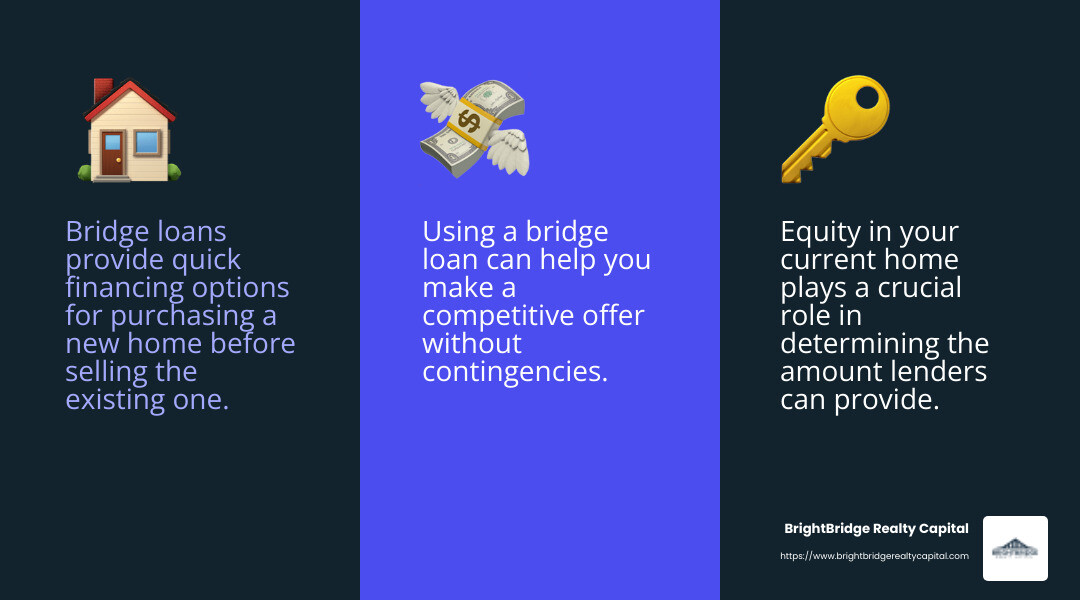Crossing Over: A Guide to Real Estate Bridge Loans

Bridge loan real estate is a crucial topic for any investor looking to steer the challenges of buying and selling properties simultaneously. These short-term loans provide the transitional financing needed when moving from one property to another. Whether you're in the midst of a fix-and-flip project or expanding your rental portfolio, understanding bridge loans can be the key to seizing real estate opportunities efficiently without being bogged down by prolonged traditional loan processes.
Quick Facts:
- Purpose: Transitional financing for buying a new property while selling an existing one.
- Duration: Typically 6 months to 1 year.
- Interest Rates: Generally higher than conventional loans, about 2% above prime rate.
- Requirements: Often need at least 20% equity in your current home, plus a good credit score.
In the world of real estate investment, speed and flexibility are paramount. Bridge loans offer a way to act swiftly, providing the funds to secure a new property even if your current one hasn't sold yet.
"If you need to move quickly, you want to go to someone that can offer certainty of execution and coordinate multiple types of capital under one roof," – John Hofmann, JPMorganChase.

Basic bridge loan real estate glossary:
What is a Bridge Loan?
A bridge loan is a short-term loan that fills a financing gap. It helps homeowners and businesses get the funds they need before long-term financing kicks in or an existing obligation is paid off. Often used in real estate transactions, bridge loans are a lifeline when you need immediate cash flow to secure a new property while waiting for your current one to sell.
Characteristics of Bridge Loans
Duration
Bridge loans are designed for quick transitions. They typically last from 6 months to 1 year. This short duration is ideal for those who need to bridge the gap between selling one property and buying another.
Repayment Terms
Repayment terms for bridge loans can vary. Some lenders require monthly payments, while others might allow interest-only payments or defer payments until the end of the loan term. This flexibility can help borrowers manage cash flow during a transitional period.
Interest Rates
Interest rates for bridge loans are usually higher than those for conventional loans. They often run about 2% above the prime rate. Borrowers pay for the convenience of quick access to funds, knowing that the loan is short-term and will be replaced by more permanent financing.
Collateral
In real estate, your current home often serves as collateral for a bridge loan. This means if you default on the loan, the lender can take your property. It's a significant risk, but for many, it's a necessary step to secure a new home before the old one sells.

Bridge loans are a useful tool in real estate. They offer a way to act quickly and decisively, which is crucial in a competitive market. However, the higher interest rates and the need for collateral mean they are not without risk.
In the next section, we'll explore how bridge loans work in real estate, including their role in purchasing new homes and dealing with existing home sales.
How Bridge Loans Work in Real Estate
Bridge loans provide a financial bridge to help homeowners buy a new home while waiting to sell their existing one. This type of bridge loan real estate solution is particularly useful in fast-moving markets where timing is everything.
Bridge Loan Use Options
Equity and New Home Purchase
When you're eyeing a new home, but your current one hasn't sold yet, a bridge loan can be your ticket to making the purchase. The equity in your existing home plays a crucial role here. Lenders look at the equity as a safety net, using it to determine how much they can lend you. The more equity you have, the better your chances of securing a bridge loan to cover the down payment on your new property.
Existing Home Sale
Bridge loans are often used to manage the transition from one home to another. They allow you to buy a new home before selling your current one. This can be particularly advantageous if you find your dream home but haven't yet secured a buyer for your existing property. Once your current home sells, you can use the proceeds to pay off the bridge loan.
Second Mortgage
One option with bridge loans is to use them as a second mortgage. This means you take out a loan on top of your existing mortgage to cover the down payment on your new home. This is useful if you want to move quickly and can't wait for your current home to sell.
Pay Off Old Mortgage
Another strategy is using a bridge loan to pay off your old mortgage entirely. In this scenario, you take out a larger bridge loan that covers the remaining balance on your existing mortgage and provides extra funds for the down payment on your new home. This can simplify your financial obligations by consolidating them into one loan, albeit temporarily.
Down Payment
Securing a down payment is often the biggest hurdle when buying a new home. A bridge loan can help by providing the necessary funds upfront, giving you the flexibility to make a competitive offer without waiting for the sale of your current home.

In summary, bridge loans offer several options for homeowners looking to transition smoothly between homes. They allow you to leverage your existing home equity to secure a new home, manage the sale of your current property, and handle down payments effectively. However, weigh these benefits against the potential risks and costs, such as higher interest rates and the need for collateral.
Pros and Cons of Bridge Loans
Bridge loans can be a lifesaver in the world of real estate. They offer unique advantages but also come with their share of challenges. Let's break down the pros and cons to help you decide if a bridge loan real estate solution is right for you.
Pros of Bridge Loans
Quick Financing
One of the biggest advantages of bridge loans is speed. Need cash fast to secure that perfect home? Bridge loans can deliver funds in as little as two weeks. This quick turnaround can be crucial in hot markets where homes sell quickly.
No Sale Contingency
With a bridge loan, you can make an offer on a new home without waiting to sell your current one. This eliminates the sale contingency and makes your offer more attractive to sellers, giving you a competitive edge.
Competitive Offers
In a seller's market, having a bridge loan can make your offer stand out. Sellers prefer offers with fewer contingencies, and a bridge loan allows you to remove the need to sell your current home first. This can make your offer more appealing and increase your chances of securing the property.
Cons of Bridge Loans
High Interest Rates
Bridge loans usually come with higher interest rates compared to traditional loans. This is because they are short-term and riskier for lenders. While they provide quick cash, you'll pay more for the convenience.
Dual Mortgage Payments
If your current home doesn't sell quickly, you might find yourself juggling two mortgage payments. This can strain your finances, especially if the bridge loan's interest rate is high. Planning for this scenario is crucial.
Qualification Challenges
Not everyone qualifies for a bridge loan. Lenders typically require a good credit score, a low debt-to-income ratio, and significant equity in your current home. Meeting these requirements can be a hurdle for some borrowers.
In summary, bridge loans offer quick financing and the ability to make competitive offers without a sale contingency. However, they come with high interest rates, the potential for dual mortgage payments, and strict qualification criteria. Weigh these pros and cons carefully to determine if a bridge loan aligns with your financial strategy and real estate goals.
Bridge Loan Real Estate Requirements
To qualify for a bridge loan real estate solution, you'll need to meet specific requirements. These criteria are crucial because they help lenders assess the risk involved in providing you with this short-term financing. Let's break down the key requirements: credit score, debt-to-income ratio, and loan-to-value ratio.
Credit Score
A strong credit score is essential when applying for a bridge loan. Most lenders look for a score of at least 740. This number indicates to lenders that you are a reliable borrower who is likely to make timely payments. However, some lenders may have different thresholds, so it's wise to check with your specific lender about their requirements.
Debt-to-Income Ratio (DTI)
Your debt-to-income ratio is another critical factor. Lenders prefer a DTI below 50%. This ratio measures how much of your monthly income goes towards paying debts. A lower DTI suggests that you have a manageable level of debt relative to your income. This reassures lenders that you can handle the additional financial obligation of a bridge loan.
Loan-to-Value Ratio (LTV)
The loan-to-value ratio is the third key requirement. Lenders usually allow you to borrow up to 80% of your home's value. This means you should have at least 20% equity in your current home. This equity acts as collateral, reducing the lender's risk. If you don't meet the LTV requirement, you might need to explore other financing options or consider building more equity before applying.
Meeting these requirements is crucial for securing a bridge loan. That each lender may have slightly different criteria, so do your homework and understand what your lender expects. By meeting these requirements, you'll be better positioned to obtain the financing you need to move forward with your real estate plans.
Customized Financing Solutions by BrightBridge Realty Capital
When it comes to bridge loan real estate solutions, BrightBridge Realty Capital stands out with its custom approach. Here's how they make the process smooth and efficient for you:
Custom Loan Options
At BrightBridge, we understand that every real estate transaction is unique. That's why we offer a variety of custom loan options designed to fit your specific needs. Whether you're flipping a property, building from the ground up, or expanding your rental portfolio, we have the right loan solution to match your strategy. Our goal is to provide you with the flexibility you need to seize opportunities as they arise.
Expert Guidance
Navigating bridge loans can be complex, but you don't have to go it alone. Our team of real estate investment experts is here to provide expert guidance every step of the way. From your initial application to your final payoff, we manage every detail in-house. This ensures that you have a smooth and seamless experience, with custom solutions that meet your specific investment needs.
Fast Closings
In real estate, timing is everything. That's why we pride ourselves on our ability to offer fast closings. Our streamlined process often allows us to commit the same day and help customers close within one week. This quick turnaround means you can move forward with your plans without delay, giving you a competitive edge in the market.
With BrightBridge Realty Capital, you're not just getting a loan; you're getting a partner dedicated to your success. Our customized financing solutions, combined with expert guidance and fast closings, provide you with the tools you need to achieve your real estate goals.
Next, we'll dive into some frequently asked questions about bridge loan real estate to help you understand this financing option even better.
Frequently Asked Questions about Bridge Loan Real Estate
What are the typical interest rates for bridge loans?
Bridge loans usually have higher interest rates than conventional loans. Typically, they are about 2% above the prime rate. This means if the prime rate is 5%, you might expect a bridge loan to have an interest rate of around 7%. These rates reflect the short-term nature and increased risk of bridge loans compared to traditional mortgages.
How do I qualify for a bridge loan?
Qualifying for a bridge loan requires meeting specific lender criteria. Here's what you generally need:
Credit Score: An excellent credit score is often necessary. Some lenders may accept scores in the 500s, but higher scores improve your chances.
Equity: Lenders typically require you to have at least 15% to 20% equity in your current home. This acts as collateral for the bridge loan.
Debt-to-Income Ratio: A low debt-to-income ratio is preferred, although some lenders might accept ratios as high as 50%.
What happens if my home doesn't sell before the bridge loan is due?
If your home doesn't sell before the bridge loan is due, it's crucial to have a financial plan in place. Here are some steps to consider:
Repayment Terms: Understand the repayment terms upfront. Some lenders offer options to defer payments until your home sells, while others may require interim payments.
Risk Management: Have a backup plan if your home sale is delayed. This might include temporary refinancing or extending the loan term, although these options may come with additional costs.
Financial Planning: Consider consulting with a financial advisor to explore all available options and create a strategy to manage potential risks.
Understanding these aspects can help you make informed decisions and steer the complexities of bridge loan real estate with confidence.
Conclusion
At BrightBridge Realty Capital, we understand that bridge loan real estate transactions can be complex and time-sensitive. That's why we offer customized financing solutions custom to meet your specific needs. Whether you're flipping properties, building new projects, or expanding your rental portfolio, our team is here to guide you through every step.
Our unique approach emphasizes fast closings, often within a week. This speed can be crucial when you're trying to seize opportunities in a competitive market. By cutting out intermediaries, we provide direct lending with competitive rates, ensuring a seamless process from start to finish.
Choosing the right financing option can make a significant difference in your real estate investment strategy. With our expertise and commitment to flexibility, BrightBridge Realty Capital is your partner in bridging the gap between your current assets and future investments.
Explore our custom loan options today and let us help you achieve your real estate goals with confidence.


